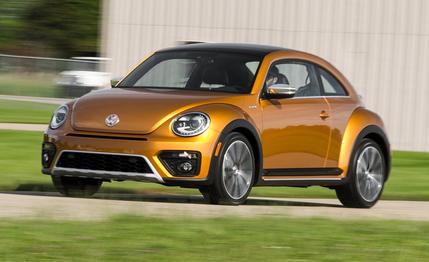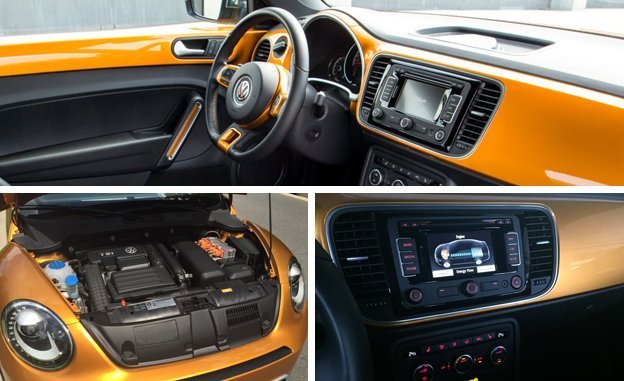
 Prototype Drive
Prototype Drive
We recently were given some seat time in Volkswagen’s Beetle Dune concept, which turned many VW fans’ heads at the 2014 Detroit auto show. Why drive what is, in terms of automotive showpieces, a relatively ancient thing? Well, the Dune is slated to enter production and arrive in early 2016, so while the show car is now fitted with a hybrid powertrain that won’t ever make it to the Beetle, it was still worth nabbing some early impressions of the jacked-up Bug . . . even if the experience was not unlike watching foreign animation without subtitles, in that we found ourselves pleasantly surprised—even entertained—but mostly confused.
VW calls this version of the Dune the “Beetle Hybrid Concept” on account of it packing the current Jetta hybrid’s powertrain. (The original concept had a 2.0-liter turbocharged four-cylinder and no electrification.) That means the EA211 1.4-liter TSI turbo four teamed with a 27-hp electric motor; a 1.1-kWh lithium-ion battery pack made from 60 cells; and Volkswagen’s seven-speed DSG automatic gearbox. Total system output is rated at 170 horsepower and 184 lb-ft of torque.


The car is also our latest look at the forthcoming Dune package. Little has changed since its debut early last year: Versus the standard Beetle, the Dune gains two inches of ground clearance, 0.8 inch of total height, and 2.2 inches of width thanks to flared fenders accommodating 1.1-inch-wider tracks. The unique front and rear bumpers are still there, along with its rear spoiler and the same burnt orange/gold paint color that carries over to the interior trim. If you love the hue, good: It'll reach production as part of a two-color palette, with the other choice being silver.
Powertrain aside, the two most notable changes to the Dune in this form are the loss of the “Dune” branding inside and out—although this may only be the case for the hybrid concept, reappearing in the production version—and a big-red-button-style emergency-cutoff switch next to the emergency brake in the center console. The cutoff is probably the most bizarre element in the already-oddball hybrid concept, but there it is, in all its “do not hit the shiny, candy-like red button” glory. For the record, it’s a safeguard that Volkswagen puts in its concept cars when they’re drivable, and we managed to resist.
On the road, the concept feels similar to the current Jetta hybrid, which makes sense as they share not only powertrains but also their PQ35 architecture. We found the Jetta to be a rare fun-to-drive hybrid when we first tested a 2013 model; if anything, the Dune is even more so. This Beetle feels quicker than the Jetta—and more eager. Whereas the Jetta can be a bit slow to take off from a stop, the Beetle seems to deliver its power more immediately, without the transmission-based indecision of the Jetta. The Beetle hybrid’s regenerative brakes feel a bit more sorted as well, an improvement on one of our biggest complaints about the Jetta hybrid. Of course, we didn’t have such a Jetta on hand to compare and contrast.
The orange paint may be off-putting to some in a cheesy-surf-movie kind of way, but the Beetle Dune undeniably turns heads. Everywhere we went on our short journey, the Dune had folks rubbernecking to take it in—it’s at once subtle and completely not. The only hard news we gleaned from our time with the concept is that we should see the Dune hit dealerships next February. We previously speculated that Volkswagen’s 2.0-liter TSI engine as seen in the original concept and the Beetle R-Line may have been slated for the Dune, but a 1.8-liter TSI engine with 170 horsepower and a 150-hp, 2.0-liter TDI diesel are going to be what's on offer.


That leads us to why the Beetle hybrid concept exists at all. The official word from VW is that it’s “designed to demonstrate the flexibility of the brand's current MQB-Full Hybrid module” by installing it in the older PQ35 architecture. That’s all well and good, but we already have a living, breathing example of this in the aforementioned Jetta hybrid, and you can even go out and buy one of those if you want. As mentioned, there are no plans to release a Beetle hybrid of any kind, which makes this a very strange demonstrator indeed.
In any event, what we can say with certainty is this: Piloting the Dune on the road definitely whetted our appetite to drive the real thing. The looks strike a chord with fans of the Baja Bugs of the 1970s, even if the production model will be little more than a front-wheel-drive, front-engined, more-show-than-go attempt to cash in on that nostalgia. That’s okay, we suppose; as cash-ins on nostalgia go, the modern Beetle is perhaps the ne plus ultra example, and there really is an allure to the Dune that’s hard to define, hybrid or not. All of this to say that what’s under the hood hardly matters—buyers will either love it or they won’t.